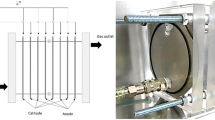Abstract
Electrolysis systems have been widely investigated for treating wastewater in laboratory-scale experiments, and most researchers reported efficient treatment outcomes. However, industrial scale implementation often necessitates assessing and prioritising various options involving different combinations of input parameters, which often requires mathematical models. This study presents mathematical models for predicting removal efficiencies of four different pollutants using electrolysis. Parametric equations were developed based on experimental results conducted in a previous study. Proposed equations are dependent on treatment retention time and current intensity (voltage). Results revealed that the experimental data followed consistent patterns, which lead to the derivations of generalised equations which were able to closely predict pollutants’ removal efficiencies obtained through experimental measurement. The developed equations also confirmed that beyond an optimum voltage, a further increase in voltage does not render higher removals of the pollutants, which is essential for enhancing the feasibility of industrial scale applications.







Similar content being viewed by others
References
Ahsan, A., Kamaludin, M., Rahman, M. M., Anwar, A. H. M. F., Bek, M. A., & Idrus, S. (2014). Removal of various pollutants from leachate using a low-cost technique: integration of electrolysis with activated carbon contactor. Water, Air, & Soil Pollution, 225(2163), 1–9.
Bayramoglu, M., Kobya, M., Eyvaz, M., & Senturk, E. (2006). Technical and economic analysis of electrocoagulation for the treatment of poultry slaughterhouse wastewater. Separation and Purification Technology, 51(3), 404–408.
Bonmatí, A., & Flotats, X. (2003). Air stripping of ammonia from pig slurry: characterisation and feasibility as a pre- or post-treatment to mesophilic anaerobic digestion. Waste Management, 23(3), 261–272.
Curteanu, S., Piuleac, C. G., Godini, K., & Azaryan, G. (2011). Modeling of electrolysis process in wastewater treatment using different types of neural networks. Chemical Engineering Journal, 172, 267–276.
Erabee, I. K., Ahsan, A., Jose, B., Arunkumar, T., Sathyamurthy, R., Idrus, S., & Daud, N. N. N. (2017). Effects of electric potential, NaCl, pH and distance between electrodes on efficiency of electrolysis in landfill leachate treatment. Journal of Environmental Science and Health, Part A, 52, 735–741.
Fernandes, A., Spranger, P., Fonseca, A. D., Pacheco, M. J., Ciríaco, L., & Lopes, A. (2014). Effect of electrochemical treatments on the biodegradability of sanitary landfill leachates. Applied Catalysis B: Environmental, 144, 514–520.
Gößling, S., Stypka, S., Bahr, M., Oberschachtsiek, B., & Heinzel, A. (2018). Proton exchange membrane water electrolysis modeling for system simulation and degradation analysis. Chemie Ingenieur Technik, 90, 1437–1442.
Kabuk, H. A., Ilhan, F., Avsar, Y., Kurt, U., Apaydin, O., & Gönüllü, M. (2014). Investigation of leachate treatment with electrocoagulation and optimization by response surface methodology. CLEAN - Soil Air Water, 42(5), 571–577.
Mahmoud, A., & Hoadley, A. (2012). An evaluation of a hybrid ion exchange electrodialysis process in the recovery of heavy metals from simulated dilute industrial wastewater. Water Research, 46, 3364–3376.
Sousa, D. D. P. D., Pinto, C. F., Tonhela, M. A., Granato, A. C., Motheo, A. D. J., Lima, A. D. F., Ferreira, D. C., Fernandes, D. M., Fornazari, A. L. D. T., & Malpass, G. R. P. (2019). Treatment of real dairy wastewater by electrolysis and photo-assisted electrolysis in presence of chlorides. Water Science and Technology, 80(5), 961–969.
Tao, H.-C., Lei, T., Shi, G., Sun, X.-N., Wei, X.-Y., Zhang, L.-J., & Wu, W.-M. (2014). Removal of heavy metals from fly ash leachate using combined bioelectrochemical systems and electrolysis. Journal of Hazardous Materials, 264, 1–7.
Wang, C., Chou, W., & Kuo, Y. (2009). Removal of COD from laundry wastewater by electrocoagulation/electroflotation. Journal of Hazardous Materials, 164(1), 81–86.
Zailani, L. W. M., Amdan, N. S. M., & Zin, N. S. M. (2018). Removal efficiency of electrocoagulation treatment using aluminium electrode for stabilized leachate. IOP Conference Series: Earth and Environmental Science, 140, 012049.
Zoulias, E., Varkaraki, E., Lymberopoulos, N., Christodoulou, C., & Karagiorgis, G. (2004). A review on water electrolysis. The Cyprus Journal of Science and Technology, 4, 41–71.
Author information
Authors and Affiliations
Corresponding author
Additional information
Publisher’s Note
Springer Nature remains neutral with regard to jurisdictional claims in published maps and institutional affiliations.
Rights and permissions
About this article
Cite this article
Imteaz, M.A., Ahsan, A., Kaur, P. et al. Mathematical Modelling for Predicting Pollutant Removal Efficiencies of an Electrolysis System. Water Air Soil Pollut 231, 438 (2020). https://doi.org/10.1007/s11270-020-04809-2
Received:
Accepted:
Published:
DOI: https://doi.org/10.1007/s11270-020-04809-2




